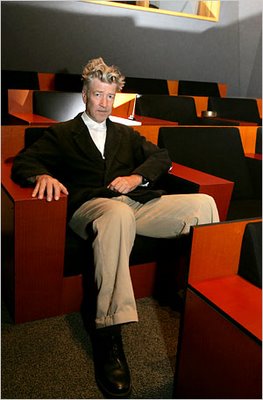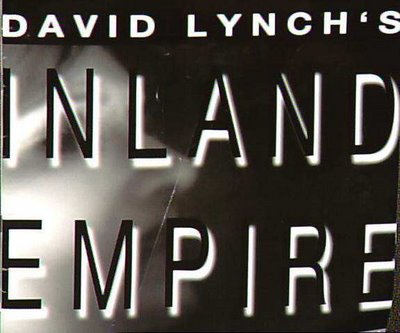Lynch y el fin del cine analogo-

Esto aparecio ayer en el NYT -- Lynch esta lanzando su "alucinante" y, segun otros, "demente" nuevo film: INLAND EMPIRE, en el mismo Lincoln Center, donde estuvimos la semana pasada. Antes la lanzo en Venecia. Lo interesante de este articulo (coloco extractos) son sus referencias a lo digital: básicamente, dice que es una etapa pasada. Lo compara con el vinilo. "El cielo es el límite con lo digital" (vayan a ver Miami Vice) y, agrega Lynch, de 60 años, y que practica todos los dias la meditacion trascendental, el celuloide "se parece a los dinosaurios que se quedaron pegados en los pozos de brea".
Si Lynch y Mann, entre otros, lo hacen, por qué no uno.
tal como Woody Ällen, que sigue en 35mm, Lynch está encontrando su dinero afuera de su país (¿ganaría un Fondart?). Cdo les vendio su nva peli a sus productores, les dijo 2 cosas: que seria en digital y q no sabia de q se trataría. Grande.
David Lynch Returns: Expect Moody Conditions, With Surreal Gusts
By DENNIS LIM
TO hear him tell it, David Lynch has spent the last five years killing the thing he loves, for fear that it will kill him first.
“The sky’s the limit with digital,” he said in a recent conversation, his voice approaching foghorn pitch. “Film is like a dinosaur in a tar pit. People might be sick to hear that because they love film, just like they loved magnetic tape. And I love film. I love it!”
He contorted his face into an expression that suggested pain more than love. “It’s so beautiful,” he said. But “I would die if I had to work like that again.”
Not one for understatement or half measures, Mr. Lynch takes a giant leap into the post-celluloid future with the three-hour “Inland Empire,” his first feature since “Mulholland Drive” in 2001, his 10th overall and the first to be shot on the humble medium of digital video. The movie had its premiere last month at the Venice Film Festival, where Mr. Lynch, who turned 60 in January, was awarded a Golden Lion for career achievement. It will have its first North American showings at the New York Film Festival on Oct. 8 and 9.
On this clear Los Angeles morning, his first at home after three weeks in Europe, Mr. Lynch was knocking back a huge cappuccino in his favorite corner of his painting studio, a scatter of stale cigarette butts on the cement floor around his Aeron chair.
“It’s actually cleaner that I thought it would be,” he said, looking around. The sunlit atelier is perched atop one of the three sleek concrete structures that make up his compound in the Hollywood Hills. He lives in one building; another is the office of his production company, Asymmetrical. This one, the hub of creative activity, served first as a location for his 1997 film “Lost Highway” and was later converted into a production facility with a recording and editing studio and a screening room. (Mr. Lynch’s chair, off limits to anyone else, can be identified by the sizable ashtray on the armrest.)
The moods and objects throughout inevitably bring to mind that most resonant of eponymous adjectives: Lynchian. Corridors and stairwells are minimally lighted. One room has the signature red curtains. Propped against one wall is an Abstract Expressionist canvas by Mr. Lynch, a brown expanse with a violent splotch of blue and the inscription “Bob loves Sally until she is blue in the face.” A photograph of the Maharishi Mahesh Yogi, the Transcendental Meditation guru, sits on a conference table, sunlight illuminating a single cobweb that hangs from its gold frame.
As it turns out, some of Mr. Lynch’s online experiments found their way into “Inland Empire,” which, despite his claims for the speed of direct video, took three years to make. It was shot in fits and starts and, for the longest time, on his own dime and without a unifying vision. At the outset, “I never saw any whole, W-H-O-L-E,” he said. “I saw plenty of holes, H-O-L-E-S. But I didn’t really worry. I would get an idea for a scene and shoot it, get another idea and shoot that. I didn’t know how they would relate.”

Only after the project was well under way did he contact the French studio Canal Plus, which financed the transformation of “Mulholland Drive” from a rejected television pilot into a feature film. Canal Plus signed on to “Inland Empire” even though, Mr. Lynch said, “I told them two things: ‘I don’t know what I’m doing, and I’m shooting on D.V.’ ”
Eventually the grand design revealed itself. In interviews Mr. Lynch has repeatedly advanced a poetic, democratic notion of ideas as independent of the artist, waiting to be plucked from the ether, or, in his preferred analogy, reeled in: he’s working on a book about the creative process titled “Catching the Big Fish.” With “Mulholland Drive,” he said the eureka moment came while he was meditating. With “Eraserhead,” his indelible debut in 1977, inspiration came while reading the Bible. (He declined to specify the passage.) There was no equivalent lightning bolt on “Inland Empire,” but in due course “something started to talk to me,” he said. “It was as if it was talking to me all along but I didn’t know it.”
A thoroughly instinctual filmmaker, Mr. Lynch could never be accused of overthinking things. Or of overtalking them. In discussions of his work he reverts to affable stonewalling tactics, deflecting detailed or analytical probes with a knowing vagueness.
The vertiginous “Inland Empire” is sure to provoke questions about meaning, literal and metaphoric. Still without a United States distributor, this may be his most avant-garde offering since “Eraserhead.” In tone and structure the film resembles the cosmic free fall of the mind-warping final act in “Mulholland Drive.”
“Inland Empire” refers on one level to the landlocked region east of Los Angeles but also evokes the vast, murky kingdom of the unconscious. Like “Lost Highway” and “Mulholland Drive,” the new movie is hard-wired into its protagonist’s disintegrating psyche, a condition that somehow prompts convulsive dislocations in time and space.
Laura Dern, who worked with Mr. Lynch on “Blue Velvet” and “Wild at Heart,” plays an actress who lands a coveted role, only to learn that the movie, a remake, may be cursed: the original was aborted when both leads were murdered. Actor becomes character. Fiction infects reality. The various narrative strands — plagued by déjà vu, doppelgängers and the menacing ambient drone of Mr. Lynch’s sound design — start to unravel. Shuttling between California and Poland, the movie folds in a Baltic radio play, a Greek chorus of skimpily dressed young women and a ghostly sitcom featuring a rabbit-headed cast and an arbitrary laugh track.

The genesis of “Inland Empire” was a 14-page monologue he wrote for Ms. Dern. They shot it once, in a 70-minute take, on a set built in his painting studio. The scene is carved up and strewn throughout the film but remains its dark heart.
Watching “Inland Empire,” which makes little attempt to temper the harshness of video, it’s hard not to miss the tactile richness of Mr. Lynch’s celluloid images. Instead of a state-of-the-art high-definition camera, he used the Sony PD-150, a common midrange model.
“Everybody says, ‘But the quality, David, it’s not so good,’ and that’s true,” Mr. Lynch said. “But it’s a different quality. It reminds me of early 35-millimeter film. You see different things. It talks to you differently.”
Mary Sweeney, Mr. Lynch’s longtime producer (and ex-wife), called the new film a return to the obsessive experimentation of “Eraserhead,” which he also shot piecemeal over several years. “David got very excited about the ways the new technology could liberate him,” she said. “I think it took him back to a pure and fearless way of working.”
Mr. Lynch also stressed the importance of fearlessness. “Fear is like a tourniquet on the big tube of creative flow,” he said. And thanks to meditation, “negative things decrease,” he added. “You get more ideas. You catch them at a deeper level.”
“As soon as you put things in words, no one ever sees the film the same way,” he said at one point, when the line of questioning turned too specific. “And that’s what I hate, you know. Talking — it’s real dangerous.”

<< Home